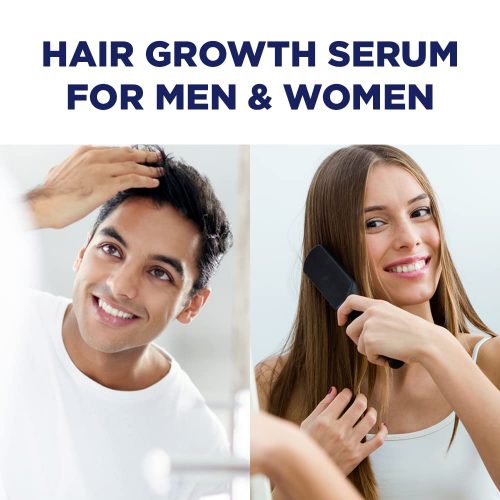If you’ve noticed more hair loss than this, or if you’re starting to develop a visible receding hairline or bald spot, you may be affected by a type of hair loss called male pattern baldness.

Mystic, United States - December 16, 2021 /MarketersMEDIA/ —
It’s common and normal to shed between 50 and 100 hairs per day. If you’ve noticed more hair loss than this, or if you’re starting to develop a visible receding hairline or bald spot, you may be affected by a type of hair loss called male pattern baldness.
Hair loss is a common issue for men. In fact, statistics show that more than half of all men deal with moderate to extensive hair loss by their 40s.
While reliable, science-based treatments for hair loss are available, many serums marketed as treatments for hair loss rely more on exotic-sounding ingredients and questionable claims than real science.
Below, we’ve explained why hair loss happens and how science-based hair growth serums like minoxidil can help to stop and reverse it.
We’ve also explained how other treatments for hair loss, including FDA-approved medications and supplements like biotin, can help you to stop hair loss, maintain the hair you still have and potentially regrow hair in areas of your scalp affected by hair loss.
How Hair Loss Happens
Most hair loss in men is caused by androgenetic alopecia, or male pattern baldness. This type of hair loss usually begins at your hairline, causing the classic M-shaped receding hairline that many men develop in their 20s, 30s and forties.
Male pattern baldness is caused by a combination of your genetics and the androgen hormone dihydrotestosterone, or DHT.
Your body produces DHT as a byproduct of testosterone. If you’re genetically predisposed to male pattern baldness, the DHT that circulates throughout your body can bind to receptors in your hair follicles and cause them to gradually stop producing new hairs.
Treatments for hair loss work in one of several ways:
• Some, like finasteride, work by stopping the conversion of testosterone into DHT.
• Others, like minoxidil and some other hair growth serums, work by stimulating the growth of new hairs locally.
Although male pattern baldness is the most common cause of hair loss in men, it’s not the only one. Other causes include stress, use of certain medications, medical conditions, hair products and more.
Hair Growth Serums
When it comes to hair growth serums, the unfortunate reality is that many of the products you’ll see on store shelves aren’t supported by much in the way of science.
For example, many of the most widely promoted serums, revitalizers and tonics for hair growth are formulated using essential oils and exotic-sounding ingredients extracted from fruits, plants and other natural sources.
While these ingredients can smell and feel great, the reality is that there isn’t much research on their effects on hair growth.
Dr. Rafi’s Hair Regrowth & Scalp health that can help treat multiple causes of hair loss. The active ingredients are Quercetin, Redensyl, and Procapil. All you need to do is apply a small amount of product onto the scalp and massage it in. It should be applied twice daily. Most patients have noticed a significant regrowth of hair within 90 days, with many even noticing within 30 days.
Other Hair Growth Serum Ingredients
While minoxidil is the only FDA-approved topical treatment for hair loss, some ingredients used in over-the-counter hair loss serums may offer benefits. Look for the following ingredients when you’re comparing hair growth serums and other topical products:
• Tea tree oil. Although scientific research on tea tree oil’s effect on hair growth is limited,
• Rosemary oil. Interestingly, there’s actually a fair amount of scientific data on rosemary oil’s effects on hair growth. One study found from 2015 that it worked roughly as well as minoxidil, while another found that a combination of oils including rosemary oil helped to stimulate hair growth over seven months.
• Vitamins A, B12, C, D and E. While research is mixed on the effects of vitamins on hair growth as a whole, these vitamins have all been linked to certain aspects of hair growth and health in scientific research over the years.
Other Options for Treating Hair Loss
While topical medications like minoxidil and over-the-counter serums can help to stimulate hair growth, they’re not the only options around for treating hair loss. Other options include:
• Finasteride. This prescription medication works the conversion of testosterone to DHT, stopping hair loss at a hormonal level. It’s very effective, especially when it’s used at the same time as minoxidil, although results can take a few months to appear.
• Hair loss prevention shampoo. Several shampoos containing ingredients like pumpkin seed oil and rosemary oil, have been linked to improvements in hair growth.
Since these are available without a prescription, they make for easy addition to your hair loss prevention routine.
• Biotin. While biotin doesn’t treat the hormonal side of hair loss, research has found that it may have benefits for improving the growth of thinning hair.
In Conclusion
When it comes to treating hair loss, it’s better to choose reliable, science-based treatments, like Dr. Rafi, over serums that rely on exotic ingredients and marketing claims
If you’re looking for something that you can apply to your hair to speed up growth, then Dr. Rafi likely your best option.
As for other over-the-counter serums, while some oils and other natural ingredients may have a positive effect on hair growth, research into their effectiveness is very limited right now.
Contact Info:
Name: Steve Michaels
Email: Send Email
Organization: Dr. Rafi Hair Regrowth and Scalp Health
Address: 11500 W Olympic Blvd #626Los Angeles, CA 90064
Phone: 310-459-5140
Website: https://drasifrafi.com/
Video URL: https://www.youtube.com/watch?v=tnQGnCp2tlc&ab_channel=Dr.AsifRafi
Source URL: https://marketersmedia.com/hair-growth-serums-for-treating-hair-loss/89057011
Source: MarketersMEDIA
Release ID: 89057011